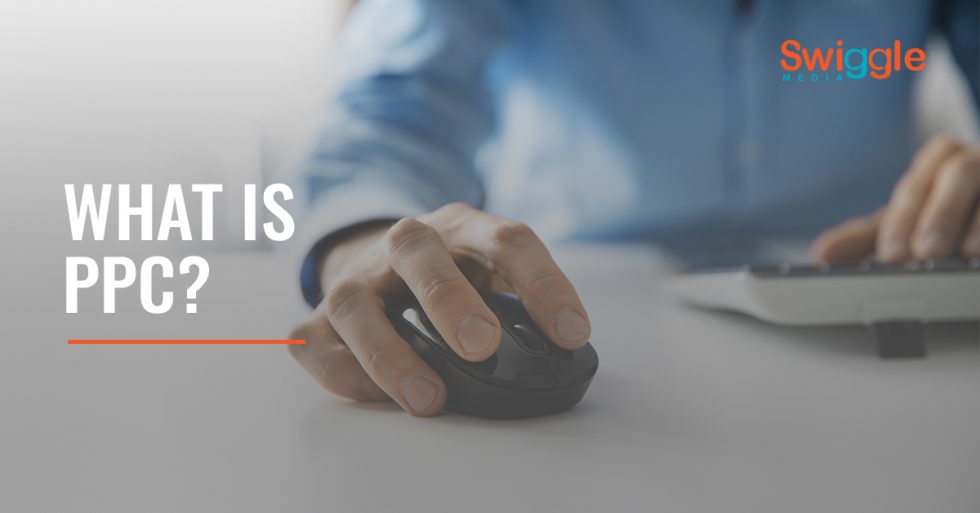This is a long one but I assure you, learning about the critical steps it takes to optimize your website for search engines will do two things;
- Give you the tools to do SEO for your business
- Give you the knowledge to properly hire an SEO company
To be completely honest, I want your business. I figured the best way to show you that we’re the company for your SEO needs is to show you how knowledgeable we are in what needs to be done to rank your company’s website. This step by step guide is the exact outline of what we do for other companies to ensure they achieve a high ranking and it’s what we’ll do for your company too.
We totally get it if you don’t read the whole thing, it’s a lot to get through and you’re a busy person. You have roofs to repair, insurance companies to call, and homeowners to help. Sifting through a 5500 word SEO guide probably wasn’t on your agenda for the day. But if you bear with me, you’ll see that I know what I’m saying and I have a plan for the success of your company’s website. This is what Swiggle Media can do for you.
Table of Contents
This is a play-by-play that is reflective of what Swiggle Media would do if you hired us plus a guide to help you do it on your own. You can use the following links to jump to different sections. We’re going to cover:
- Tracking ROI
- Desirable Keywords
- Your Competitors use SEO!
- Improving the Structure of your Website
- Get Ranked in Local Searches
- Creating Great Content
- Building High Quality Links
Chapter 1 – Tracking ROI
It sounds strange for me to be talking about tracking ROI (return on investment) before I even implement any changes to your website but understanding the last step in the process at the start is what makes our campaigns so powerful. Without analytics, all marketing efforts are pointless. If you don’t know whether your marketing strategies are being in leads, customers, clicks, or new jobs, then what’s the point? Analytics deliver information about your website, your visitors, and their behavior. This helps figure out what’s working and what’s not. We use
2 different tools to track analytics:
Take a moment to setup these tools. They’ll give you some insight into the current standing of your site. If you need any help, there are plenty of resources out there to help. There are 3 reports that are important to note when gauging the kind of ROI that comes from your SEO efforts.
Organic Traffic Analysis
- Which tool to use – Google Analytics
- To find this report go to Audience > Mobile > Overview on the side bar
- What is the outcome? You can now see the amount of organic visits and even what device visitors are using, along with time on site, bounce rate and goal completion rate.
- This is excellent information to tell if your organic traffic is increasing over the span of your SEO campaign. If it’s not, the SEO strategy needs to change.
Here’s a visual guide to setting up Organic Filters in Analytics
-
- Click All Users and set the filter to organic traffic
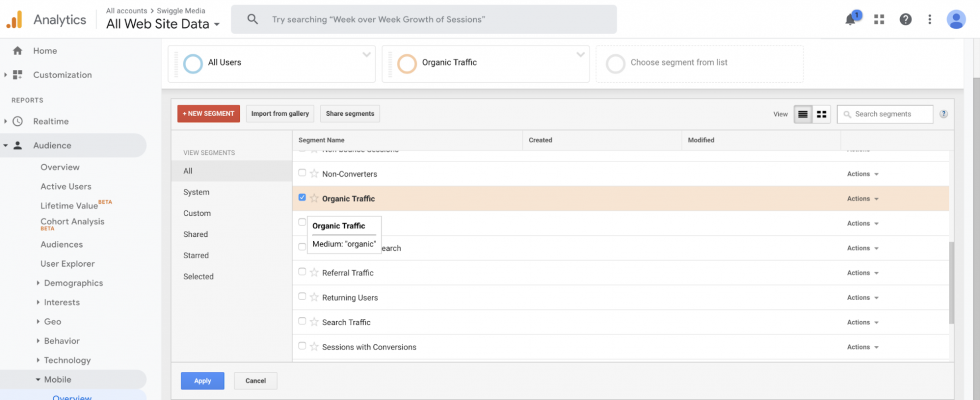
- Remove “All Sessions”
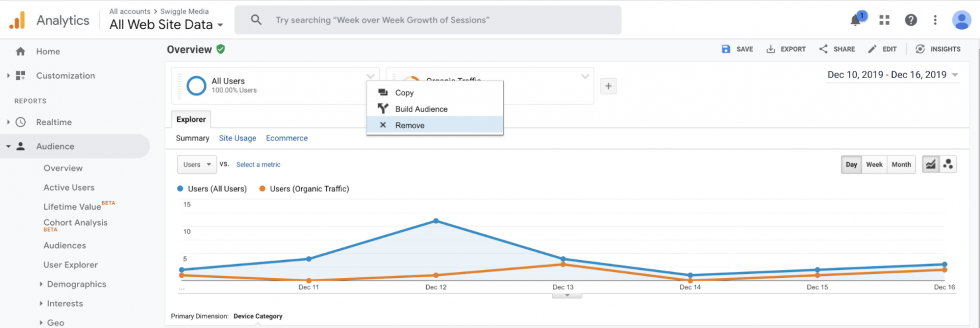
- Set dates and analyze traffic.

Analyzing the Value of SEO
Before you follow my steps for finding this report, it’s important to set up Goals tracking. Goals are for when a visitor submits a contact, newsletter, or email form on your site. Page. Here’s the step by step to set this up.
- Start on the Admin tab
- Go to Goals under View
- Click New Goal
- Where it says Goal Setup, create an account
- Proceed to Next Step
- You have free reign here. Pick a name for your goal based on what the form is. If it’s a Newsletter form enter “Newsletter Form”
- Find where it says Type and select Destination
- Proceed to Next Step
- Find Destination and select Equals to
- In the type bar, type in the exact URL to the page that appears after a form is submitted NOTE: If forms don’t redirect to a thank you page after submission, you’ll need to set up a custom event before turning it into a goal.
- Click Verify goal – If all goes well, you’ll see a conversion %
- Click Create Goal
Now we can analyze the value of SEO
- To find this on the report go to Behavior > Site Content > Landing Pages on the sidebar
- Make sure you’re looking at your organic traffic segment
- What is the outcome? This report shows which pages are receiving the most organic traffic, associated engagements and goal completions
- This report is important because good SEO makes sure that each page on your website is optimized for a set of keywords. Your conversion rates tell you which keywords hold the most value.
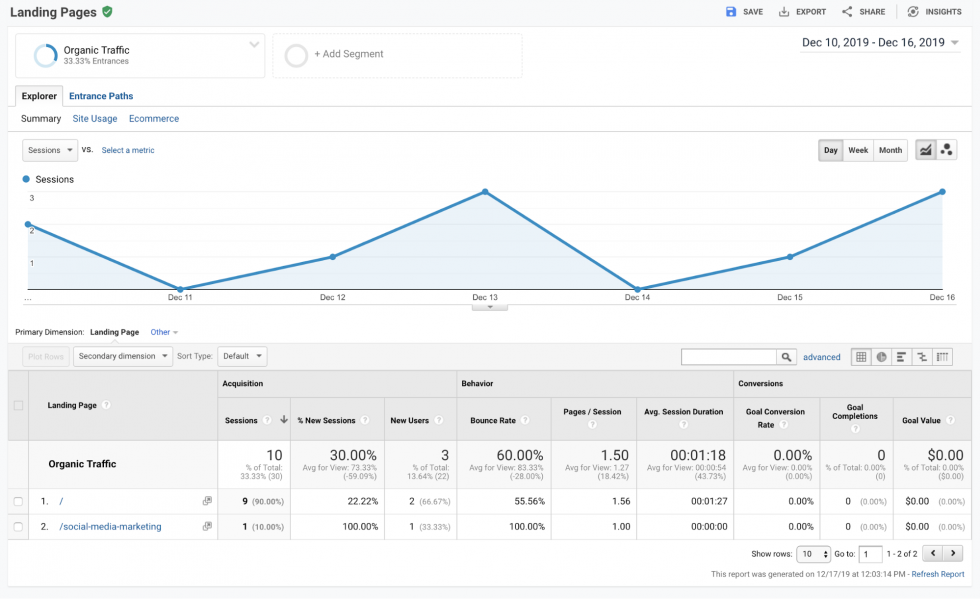
The best thing about using Google Analytics is that it tells you exactly how SEO has worked for your company! Now it’s time to see if your ROI is worth it. Here’s the information you’ll need:
- Monthly Cost= $X,XXX
- Monthly organic Traffic =
- Organic Leads =
- Organic Conversion Rate =
Input the data into an Excel spreadsheet. Then, add the amount of leads converted to customers and the total revenue gained from it.
To find your Net Profit just subtract Total Revenue Gained – Total SEO Costs = SEO Net Profit.
Now you have how much money SEO has made for you! That’s always great to look at but the best thing about analytics is that we can find out the true conversion rate of your site and calculate the potential of SEO!
Take the Total Revenue divided by Clients Gained = Average Revenue per client
Now you need to get the percentages from the chart above to multiple the Analytics Conversion Rate * Lead Conversion to Client Rate = True Conversion Rate
By changing the amount of traffic in the equation, you can estimate and gauge the impact on your revenue. The more you put in, the more you get out.
To find out how much revenue SEO can really bring, just change the amount of traffic. This will open your eyes to how much money SEO can make for you when done properly.
Chapter 2 – Desirable Keywords
Now that we’ve covered what typically comes at the end of an SEO campaign, let’s look at what happens at the beginning.
Good keyword research allows you to keep control over your page rankings, website traffic and in the end; leads. It’s so important that without it, SEO completely falls apart.
Let me lay out the process I go through to find the most effective keywords. We’ll use Orlando Roofing Company as my keyword search.
First I make a short list of similar keywords. For example:
- Orlando roofing company
- Roofing company in Orlando
- Orlando Roof Repair
- Roof Repair in Orlando
NOTE: Before you look at your screen funny, the order in which words appear does matter, so reversing them brings up different results and affects your ranking!
If you haven’t already, sign up for Keyword Planner from Google. It tells us the average monthly search volume for your chosen keywords and even suggests keywords!
Go to Keyword Planner and log into your account. The first thing you’ll see are two boxes. Click discover new keywords and input the keyword phrases we created. Click the “Get Results” button.
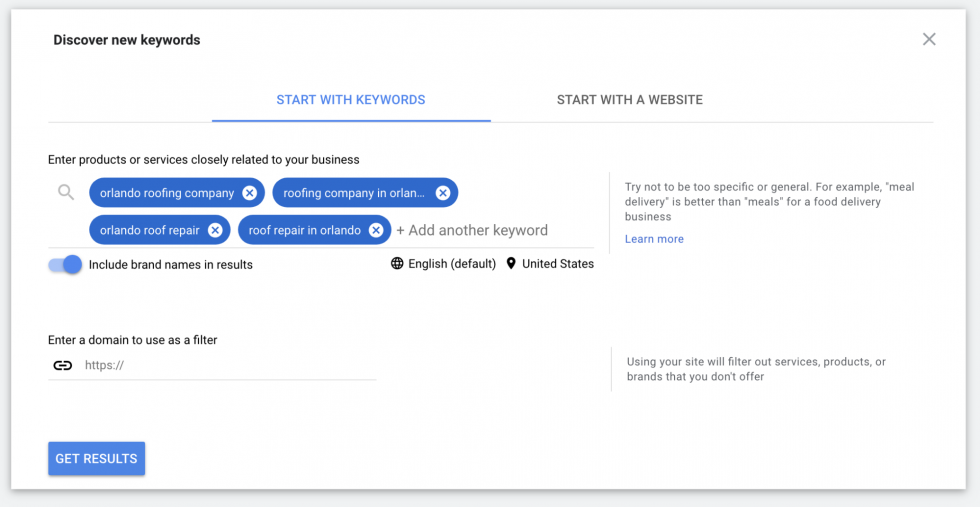
By pressing get results, it brings you to the Keyword Ideas tab of the results page. This shows you the monthly search volume, competition and suggested bid for the keywords you chose. What we want though, are they suggested keywords that are below the chart. Click the Download Keyword Ideas button at the top right.
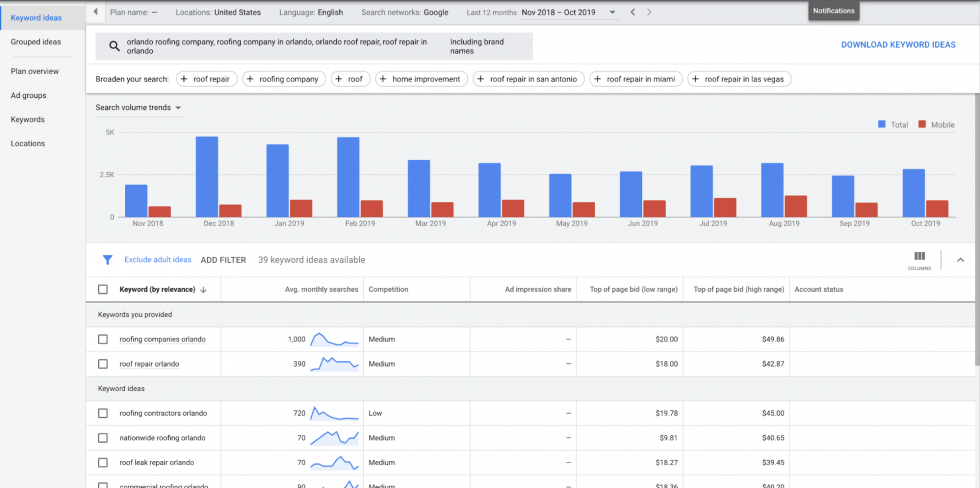
- Open the keyword ideas file and delete columns A, C, D, F, H and I.
- Next, highlight row 1, right click and select Filter > By Cell Value.
- Now, type your descriptive keyword into the search bar.
For our example the descriptive keyword is repair. Roof installation companies would use the word “installation”. If you do both, you can do searches for both.
Filtering the data helps to narrow down the many keywords we received down to those that are relevant and valuable. Going back to our initial list, the top two searches are:
- Roofing companies orlando
- Best roofing companies Orlando
As it turns out, both keywords relate to my site. However, they reflect different intent. If I try to rank for “Best roofing companies orlando” no one will consider my site because I’m selling services while they’re looking for a site to compare all the roofers in the area and save themselves some work.
Say I put a blog comparing the best roofers in orlando. Of course I’d put myself at the top and I would no longer be an unbiased source. The blog post will bring in traffic, but those visitors will never turn into leads. What we want is to make sure we collect keywords that will drive leads.
Let’s get organized. Add another column to the Excel sheet labeled Intent. Tag each keyword with Info or Purchase. Then, sort your list from high to low for monthly searches. The keyword with the highest volume is your main keyword. More on that later.
Chapter 3 – Beat your Competitors at SEO
No matter what industry you’re in, you will always have competition. Especially with SEO! Companies know how important it is to incorporate SEO into their site and they’ve either got an in-house marketing department bustling away for hours on end, or they hired a company like us to do it for them. The great thing about SEO, however, is the ability to use your competition’s advantage against them. These two free browser plugins will help us analyze the competition’s sites.
For this, we’ll use Mozbar first. Once you’ve installed the MozBar, make a google search. For example; “Roofer near me”. Make sure the M icon on the search bar is glowing blue. This means it’s on. Scroll down past the ads and map list. You’ll notice dark strips with some data on the below each organic search.
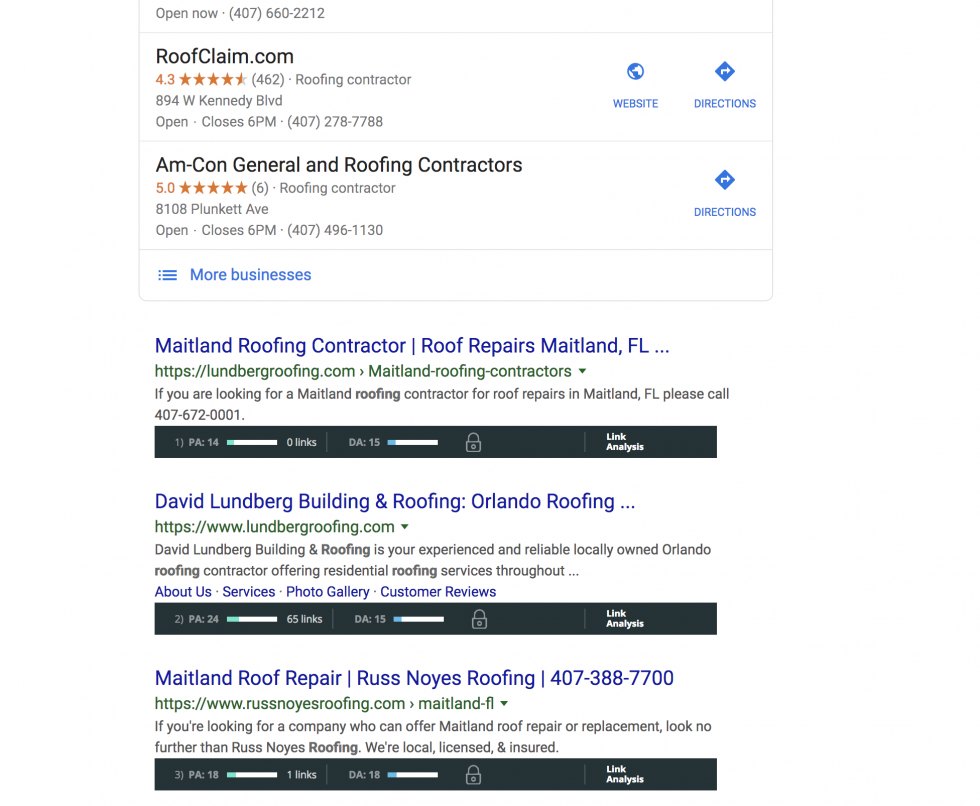
The MozBar tells you about two important statistics in the SERPs (Search Engine Results Pages):
Page Authority (PA) – How many websites are linking to the page.
Domain Authority (DA) – How many websites are linking to the root domain.
The higher these two numbers are, the harder it is to outrank. As you can see, the highest ranking page has a low PA of 14 and a low DA of 15. This means they’re ranking for proximity to my current location. If I scroll down I can find one with a PA of 33 and a DA of 44. Much better ranking. That’s my competition.
We’ll use the Majestic plug in next. We’ll find out exactly how we can outrank our competition.
The next statistics we need to pay attention to is:
Trust Flow (TF) – Quality of backlinks pointing at that domain.
Citation Flow (CF) – Power of backlinks pointing at that domain.
Anchor Text Ratio – Ratio of link anchor texts pointing at that domain.
Backlink profile – Majestic will display the indexed backlinks of any site you analyze.
Make a new tab on your spreadsheet to track all the information we’re about to get.
Add columns for Keywords, Result, PA, DA, TF, CF, Anchor, Total Links and Ref Domains.
Type your main keyword into Google.
My main keyword is roofing companies orlando.
Scroll down again till you find the first organic result. Record these items on your spreadsheet.
- Keyword – Roofing Companies Orlando
- Result – Universal Roof and Contracting
- PA – 36
- DA – 34
Click on the first organic result, skipping sites that aren’t a roofer’s company site. Sites like Yelp, Home Advisor, or BBB can almost never be surpassed because of their high PA and DA. They’re also not your competition.
Bring up the Majestic browser extension.
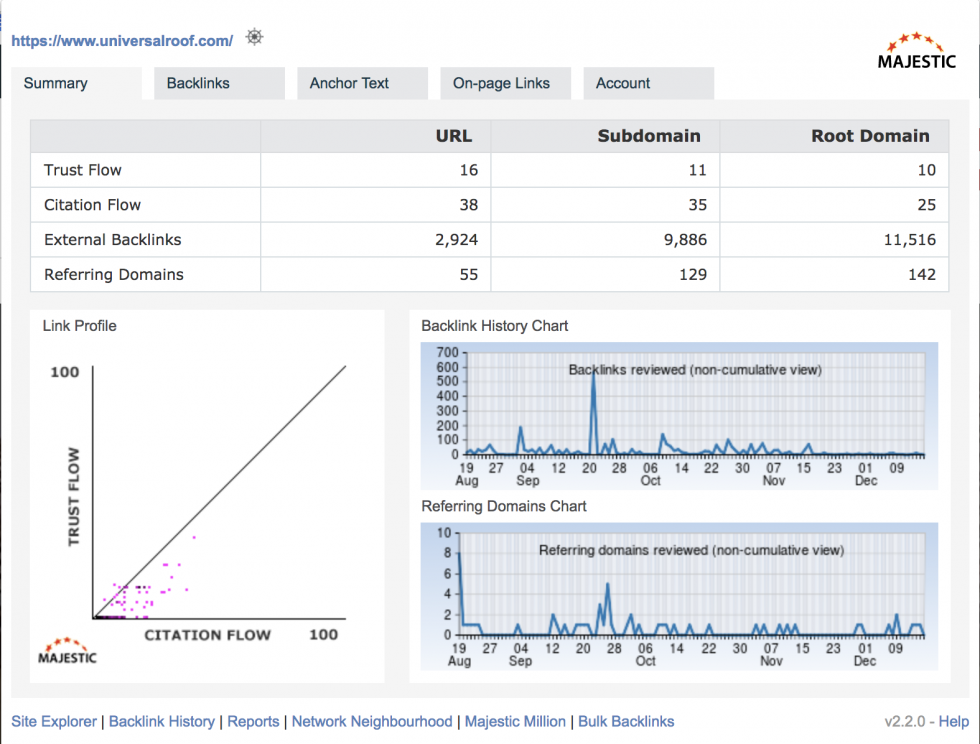
In the spreadsheet, record:
- TF – 16
- CF – 38
- Backlinks – 2,924
- Referring Domains – 55
Note: Use the URL metrics, not Root Domain.
Click on the link at the top (located on top of the Summary tab)
If you scroll down to the bottom of the screen you’ll see the Anchor Text chart. This chart tells you how other domains are linking to a site.
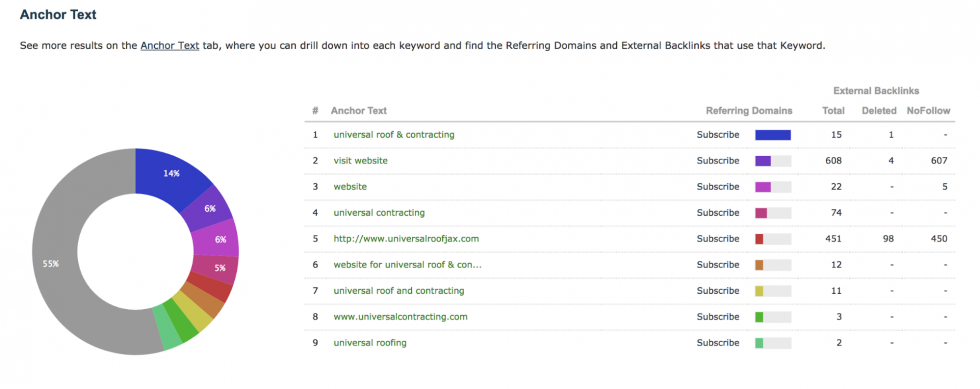
For example, let’s say I link to www.yelp.com from this post. The words I use in each link is the anchor text. It’s what’s “anchoring” the domain in place.
I’ll be honest, SEO used to be easy. Unfortunately, some companies aren’t adapting to the changes Google has made. They still throw a million links into a website to hope that it ranks. Google is smarter than that. Link dumping will get you penalized, especially if it contains the same keyword over and over.
Anyways, back to it. A quality anchor text profile should look like this:
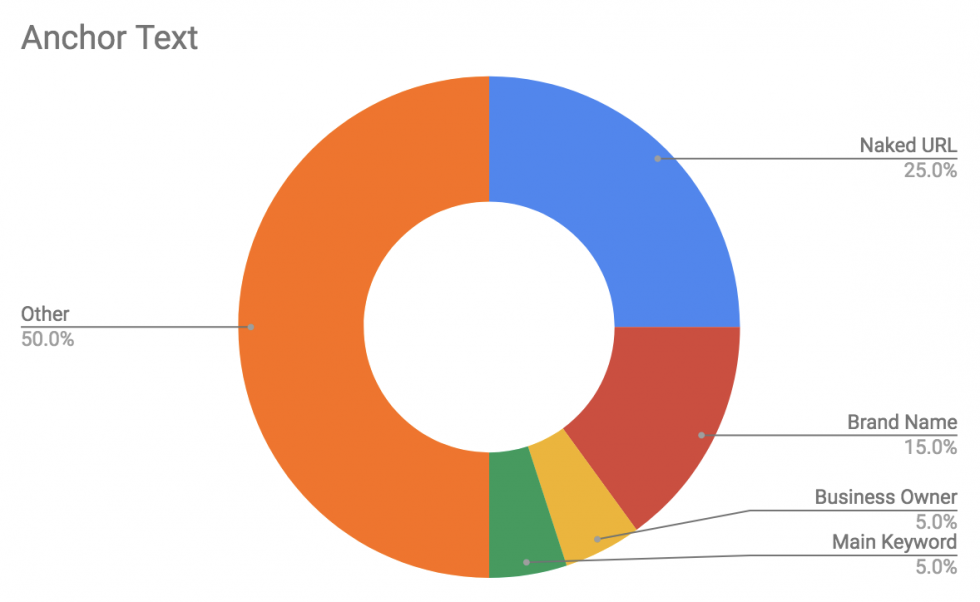
This domain’s anchor text profile is oriented correctly but not for the right things. In the Anchor column of the spreadsheet I would put “clean” because the percentages dispersed relatively close to the ideal percentages. That’s what Google sees.
When doing SEO for your site and setting up your anchor text, this information about your competitors is important because it shows you exactly what to do
There’s another site that I enjoy using for analyzing backlinks and that’s SEMRush.
If you want to stick with Majestic the directions are the same.
Go to the “Backlinks” tab and scroll to see the types of sites linking to your competitors’. An optimized link profile will have links from sites within the same niche.
Not only does our competitor have links from high quality sites, but they also have links from relevant sites. Nearly all of them have to do with roofing.
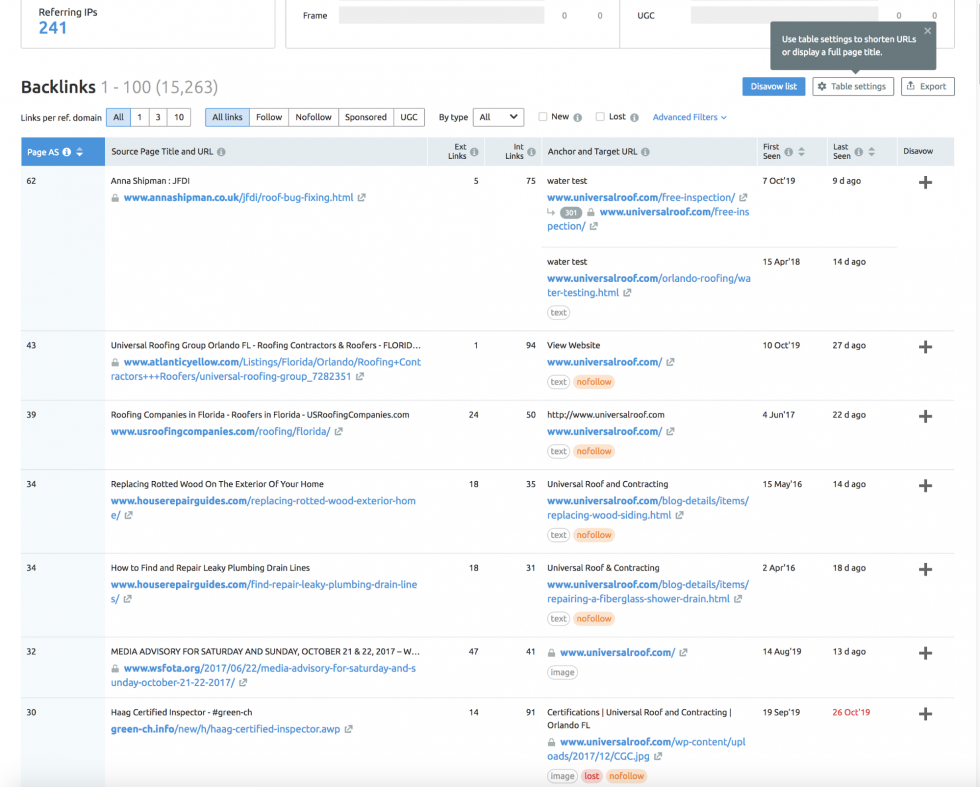
Click on a few links. Look for the TF and CF metrics and link opportunities in the subdomain: For example, my competitor’s first link is
from https://www.annashipman.co.uk/jfdi/roof-bug-fixing.html. The site has decent metrics:
- TF = 16
- CF = 31
- Backlinks = 606
Save the URL in a spreadsheet. We’ll revisit it when it’s time to build links.
Here’s where things get tedious and frustrating.
Do that whole process again for every website listed on the first page of the SERPs for your main keyword.
Yes seriously, do it.
When you start an SEO campaign on your own, you quickly realize how much work needs to be done and just how long it takes. Switching between sites, installing a bunch of plugins, and did you realize you couldn’t access the content because you weren’t a paid subscriber? Yeah, that adds up.
This is why so many people decide to outsource their SEO.
It’s nearly impossible to truly figure out how to rank number one for every single page on your site. There’s an algorithm we have to beat and the sad part is, the algorithm is never the same day by day. It’s always changing. However, if you’re an experienced SEO like me, I can create an analysis of what it will take your business to rank.
For roofers, it’s important not to use an exact match domain (EMD). I haven’t come across a roofer that only provides a single service. There’s roof inspection, gutter replacement, flat roof repair, shingle roof repair, tile roof repair, and so many different services that having your domain be something like www.roofrepair.com isn’t going to rank.
Here’s something I know for a fact.
The key to link building isn’t in shoving a bunch of links into your site. The links have to be high quality, niche relevant links. Another key component is linking to powerful sites with high PA and DA.
If I were to create an SEO campaign for you, I’d focus on building white hat links through outreach and guest blogging to outrank those in the top spot that’s rightfully yours. Last but definitely not least, I would make sure to rank in localized searches by placing your city into URLs in your site. By my calculations, this could take somewhere in the range of 3 to 5 months with a concentrated focus on content, social engagement and quality backlinks to pull ahead of the top competitors.
Chapter 4 – Improving the Structure of your Website
When it comes to the structure of your website, functionality is important. Ease of access, navigation, and user experience are all factors that determine rank. If you outsource your web design, it’s important for the designer to ask questions about your company, type of content, audience, and SEO goals. If they don’t design with SEO in mind, find someone else. There are three types of websites that are structures for roofers:
- Single service (Only roofing)
- Multiple services (general contractors, window installation, gutter replacement, and other )
- Multiple locations (you service in different cities)
Single Service
Say your company focuses on only roofing, you would structure your site this way.
This is typically the only time using an exact match domain (EMD) for your website URL would work (i.e. www.orlandooroofing.com). Typically an EMD because limits your chances to rank for other keywords but because of how specific your services are, EMD is the way to go since it contains your main keyword (a popular one at that) and location. This will rank you for localized searches.
You should have service pages that break down elements of your niche (i.e. www.orlandoroofing.com/services/spanishtile, etc). When you do this, you can start ranking for keywords that the EMD stopped you from ranking for.
Multiple Services
Say your company actually offers multiple services (Window installation, gutter repair, siding repair and more), your website will look a little different.
This is where an EMD would fail. Because you have multiple services, you would be limiting yourself to only roofing with the domain above. Use your brand in your URL (i.e. www.swigglecontractors.com).
Service pages would act the same as above but rather than creating pages for different niches within roofing, you’d create services pages for your other services (i.e. www.swigglecontractors.com/services/acrepair)
Multiple Locations
Say your company has offices in multiple locations (i.e. Orlando, Miami, Tallahassee), you’ll need to structure your site much differently.
You’re going to have to add another subsection to your website and include it in your URL (example: www.swigglecontractors.com/orlando/services/; www.swigglecontractors.com/miami/services/). Sure you could easily just add a page for your locations like everyone else but you’ll be missing out on ranking for localized searches when you don’t include the city in your URL. The hard part is, this requires you to create a new site for each city (within the primary site).
It’s basically a copy paste with location specific edits but formatting and differentiating content to avoid duplication penalties is why you need an SEO trained web designer. You’d also need to integrate menu navigation to switch between locations.
When this is done on a website, the URL changes to include the city and all your content changes with it. It’s legitimately like having a different site altogether integrated into yours.
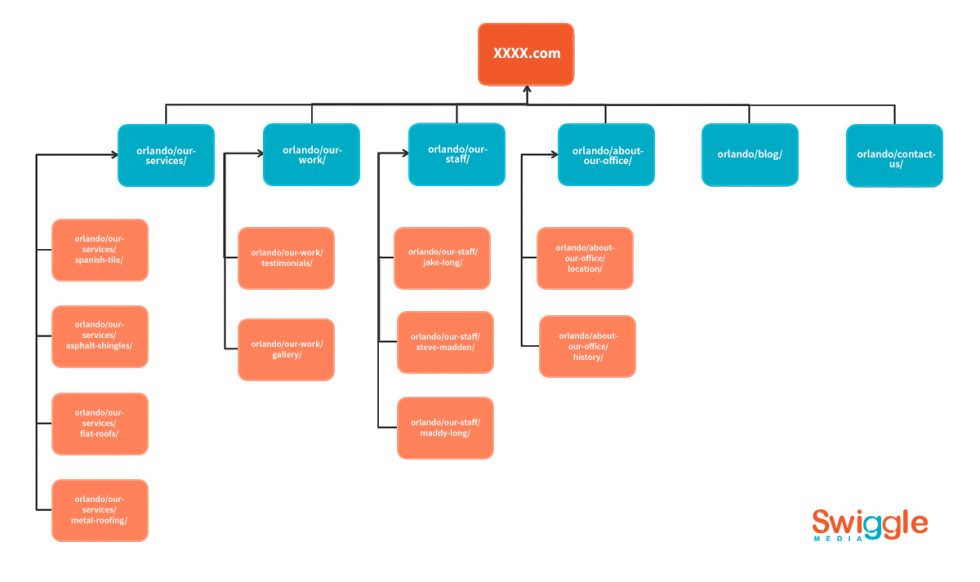
Chapter 5 – Get Ranked in Local Searches
We’ve already discussed plenty of ways to rank for local searches through our traditional SEO tactics, but there are additional things we can do to help your business rank for local searches.
Google My Business
Google My Business helps us rank for local searches. GMB page titles get displayed in localized results, rather than in the organic webpage results. This is why we need to give time and attention to GMB pages.
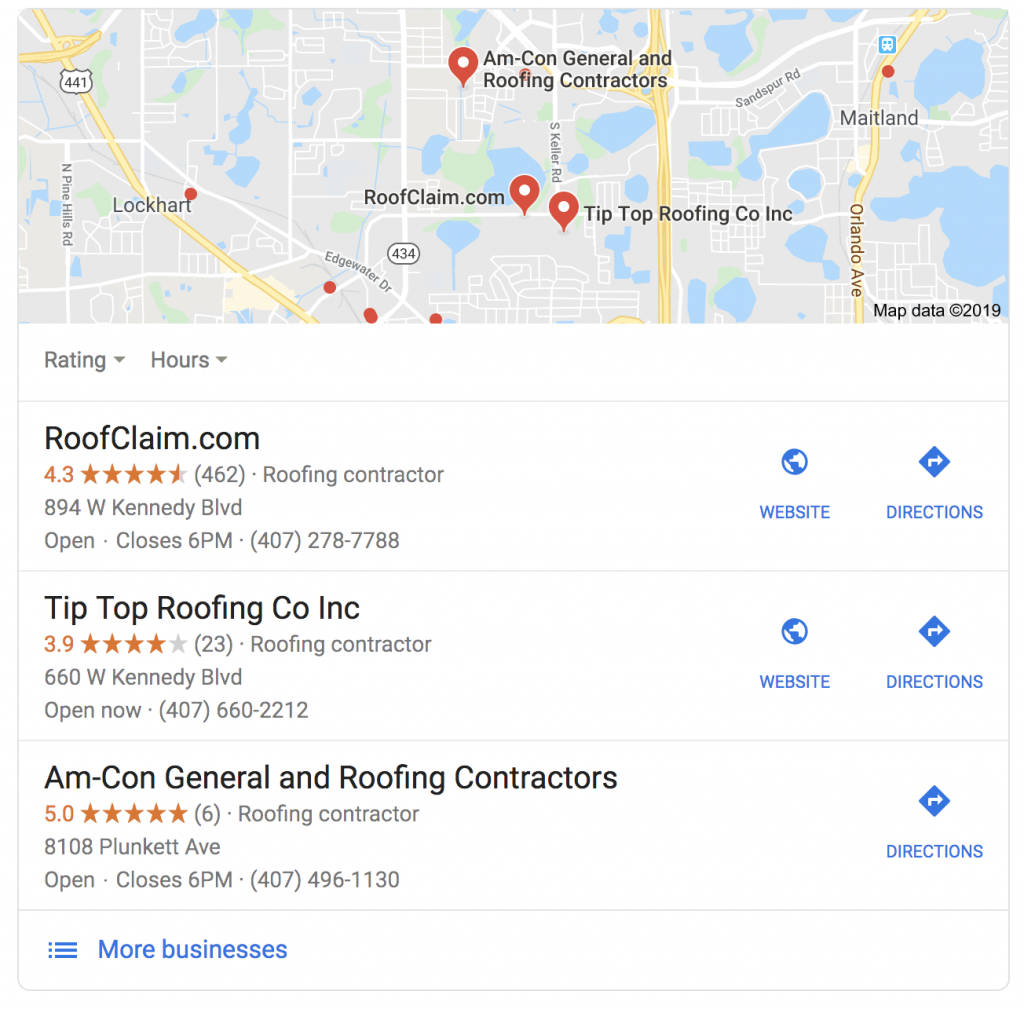
How to sign up
Go to Google My Business to sign up for a GMB page
Click on the Manage Now button then add your business to Google. Fill in the blanks with details about your company.
Don’t skip this step– Verify your location and other information ASAP! If you don’t, you’ll never show up for searches.
Now that your business is verified, go to the Complete your Listing box and add your work hours, a description of at least 150 words, and your company logo. Make sure the information you put in here is up to date.
If you already have a GMB account, here’s how you can easily integrate SEO into it.
Change your business name: Name the page with your main keyword first, followed by your brand/business name.
For example: Orlando Roofing – Swiggle Contracting
Why this works: It puts your main keyword in the title (huge ranking boost) and creates a more click-able title for when you’re ranking.
Don’t leave your description blank: Write a description of 150-200 words about your company and remember to include the services you provide and anchor each service to its respective service page.
Why this works: Anchoring your service pages into your description is another form of link building, but right in the SERPs. This will bring organic traffic to these pages and not just your home page.
Directories and Local Citations
You can create business profiles just like GMB on authoritative sites like Yelp, Brown Book, BBB, and FourSquare. Sites like these take your online presence and match it with your physical business.
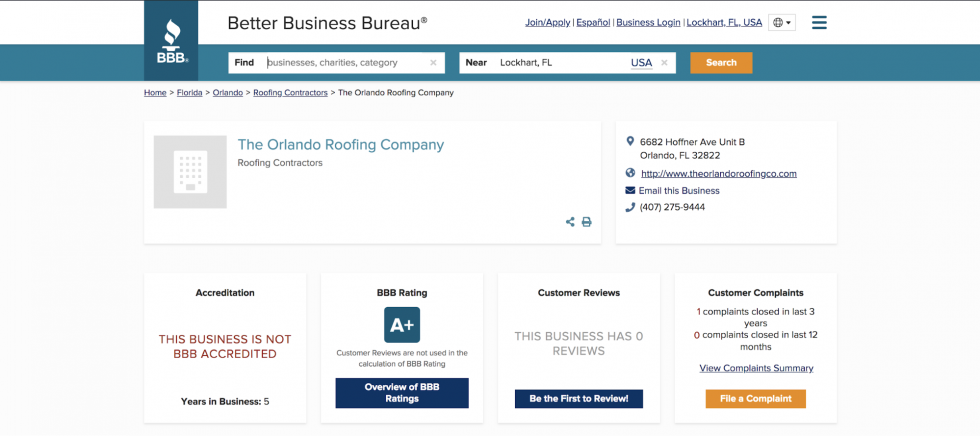
The way these directories work with SEO is that the more presence you have spread out between them, the more traffic you’ll receive. Some people exclusively use pages like BBB or Yelp to find business to work with because they rely heavily on reviews and ratings to make a choice. They know that the company’s website exists to make the company look good so why trust it’s content? Because of the importance of existing on so many of these platforms, having to make a profile for each is time consuming and is often times outsourced.
Here at Swiggle Media, I offer this service in addition to SEO and it’s a conversation I’m ready to have with you right now. Reviews work in SEO by boosting local searches and visually enticing traffic. There are multiple ways to get your reviews and testimonials to show up in searches, but they have to come from an authoritative site.
CHAPTER 6 – Creating Great Content
Hold on tight cause it’s about to be a bumpy right.
Content is a huge part of SEO and it makes all our prior efforts worth it. Your company’s potential to make great content is what SEO depends on. But it can’t just be any content. You’ve heard it once and you’ll hear it again every time you look for information about SEO; CONTENT IS KING.
Lucky for you, I know why this phrase causes so many people to fail in their SEO efforts. They don’t make quality content! Their content is the same as everyone else’s content; self-absorbed, self-praising, and only beneficial to them. It lacks substance and doesn’t give anything of value to users.
I know the best way to give value to your content in a way that increases the time users spend on your site. Blogs! But first, we need to back track a bit. Let’s head back to the list of keywords that we separated by intent. There are two different kinds of intent that we need to focus on; Purchase intent and Info intent.
Purchase Intent Keywords
When it comes to purchase intent keywords, they should be directed at your service pages. However, your service page should try to focus on a single main keyword and place it strategically on the page. They should be in these places:
- The URL
- Title of the page
- h1 tag
- 1 image title
- 1 image alt tag
- 2 – 3 times throughout the content
The minimum word count for an SEO integrated service page is 350 words of relevant content. The content should include what services you provide, what each service entails, where to obtain more information, and how to get in contact with a rep to request a quote or evaluation.
Info Intent Keywords
Most SEO companies will stop at that. They’ll completely ignore info intent because they already checked the “Content is King” box on their SEO checklist. They also focused on the area that would bring in leads, the purchase keywords.
I know my job doesn’t stop there. We won’t get Google attention by only targeting users who want to purchase your services. Google is smart. It knows that there are other users out there that they need to appeal to and they don’t want to purchase anything, they’re hungry for information.
Not only does Google know this, but Google won’t even look at your site if they don’t think the content you’re producing is of quality. How does Google determine quality? Through social shares, brand mentions, and high quality links.
Do you think someone will share your service page on Facebook and say “Hey guys, check out this page about shingle replacement services!”
“Info” type content is what people will share and link to. That’s why the key to putting out great content is a blog. Think about info intent keywords that your users would search for if they needed roofing help. Keywords like “hurricane”, “roof damage” and “insurance” are probably popular ones. You need to rebuild your content around the keywords like this. That was the easy part. The hard part is actually making content that people would want to read, share, and link to.
- How to guides – “How to be prepared for a hurricane”
- Information – “What is roof flashing?”
- Infographics – “3 common water damage issues and how to prevent them”
Always remember who your audience is. Typically they’re potential customers looking for further information, or clients who heard their contractor say something they didn’t understand and decided to search for more information on their own. You’re the expert in your field, establish authority by showing visitors that you know your stuff! This will not only bring in social shares, but it will also turn visitors into potential leads.
Chapter 7 – Building High Quality Links
Having high quality links pointing traffic towards your site is the #1 ranking factor in SEO. It’s so much more complicated than it used to be and that’s why so many marketing departments are failing, they’re using techniques that worked years ago that just don’t cut it anymore.
Google uses bots to do their ranking process. The problem with this is that you can have amazing content, be one of the best roofers in the world, but without links, the bots can’t tell. They can’t read your content directly and think “wow, this is great content. We should up-rank this one”. They analyze the back end of things, the side of the digital world you can’t see. The more surface area the links pointing to your site cover on the web, the higher the quality according to Google’s bots (as long as the sites the links come from have high authority).
The process of building trust with Google is a long and tedious process. There are so many elements you need to cover just to secure a single link, and your site should have hundreds of them. In the end, it’s all worth it.
Social Media and Forum Links
Social Media is a great place to share links from your own site. If you’re lucky, the people in your industry who see your posts will share your content on their own pages, creating a new link each time. On top of this, any likes and comments will boost the power of each link.
Quora
Quora is a high visibility question and answer site. The key to Quora is finding threads related to the content on your blog. Quora is a site where users can post questions and gain answers from other users. Often times this creates an excellent opportunity to drop a link to one of your blog posts because your post can be someone’s answer.
For example, if you wrote a blog post about “How to prepare for a hurricane”, you can go on Quora and search the question “How can I prepare for a hurricane”.
Look through the results and find one where a link to your blog post would be beneficial. Post a quick written answer and drop a link to your blog below it, like this:
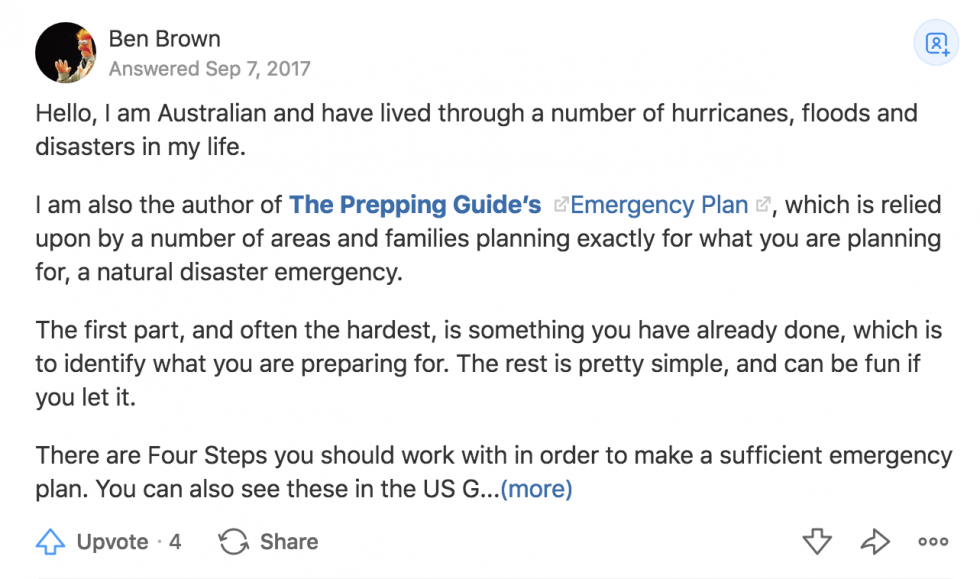
And repeat. Make sure your answers are unique and written differently so it doesn’t get marked as spam. Do this for any questions that your blog posts could potentially answer.
Link Building
When it comes to link outreach, you have to make sure your content is worthy of linking back to before you even make the attempt. You’ll waste a lot of time asking for someone to add your link to their authoritative site if the post isn’t worth their time. They’ll either reject you or ignore you completely.
Linking pages internally passes link equity and ranking signals. This is a good way to use your blog content to bolster your service pages. Think of internal link building as DIY.
You control where your links go on your own site and what text you anchor it to while distributing link equity and sending ranking signals. If you want more information about link outreach, you can check out our guide to link building.
See what I did there?
White Hat Link Building in Resource Pages
These are dedicated pages listing links to useful resources. To find these pages, use Google search operators:
- Roofing inurl:resources
- Hurricane inurl:resources
- Insurance intitle:resources
- Roofing insurance intitle:resources
- Roofing blog “resource pages”
- Contractor’s blog “resource pages”
See what I’m doing? I’m using some of the keywords we found for info intent and searching for resources where I can post blogs. The results would look something like this:
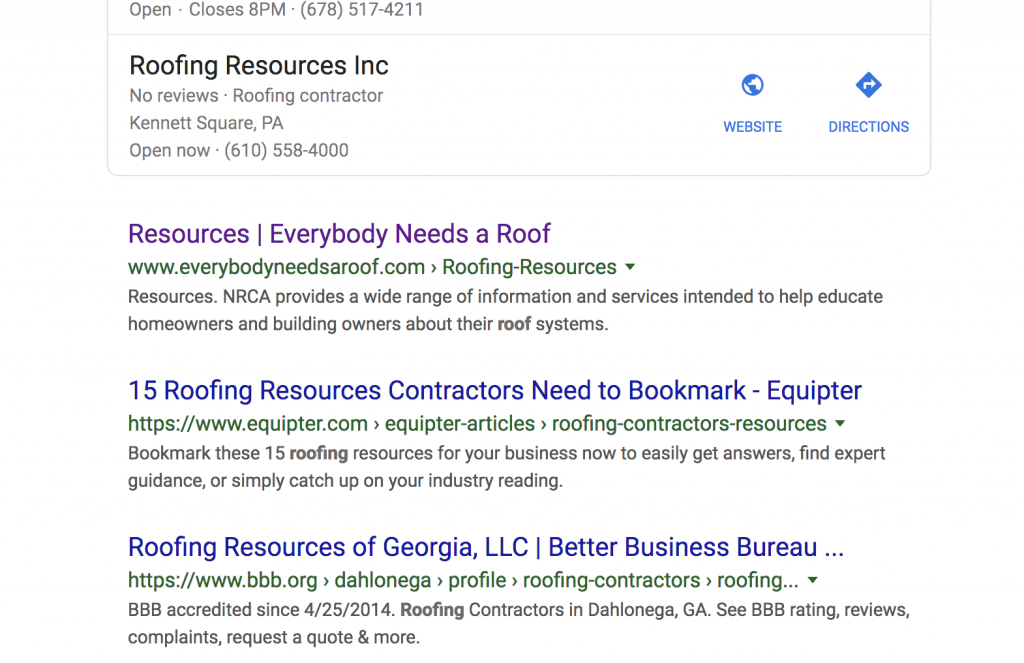
The first result that shows up is a resource page on everybodyneedsaroof.com. So I click on it and there’s an opportunity!
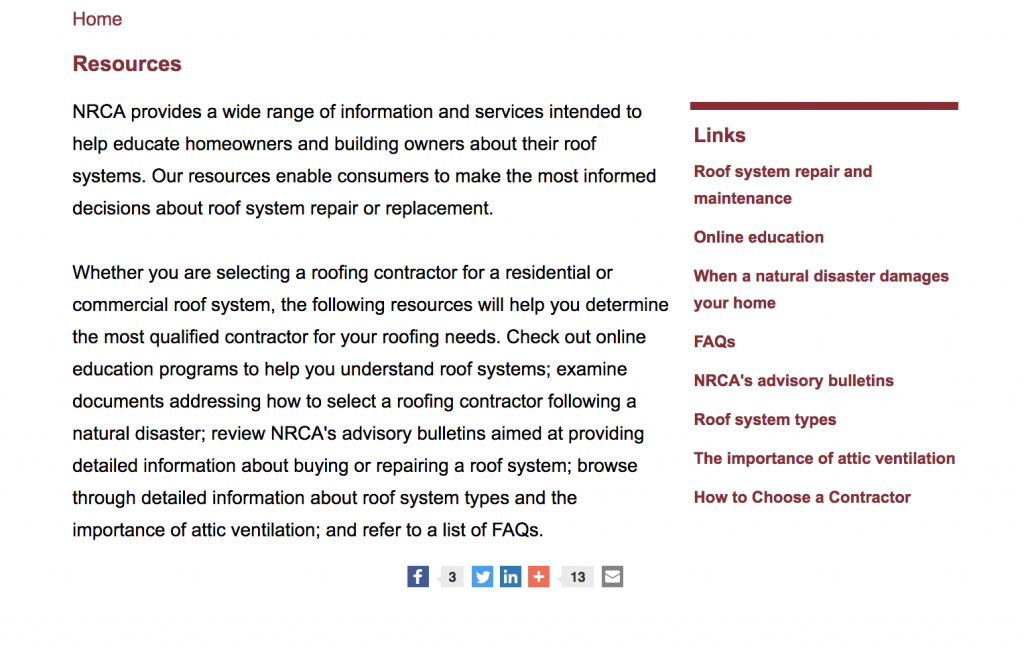
If you read the description they provide, they are a dedicated page that wants to provide resources to homeowners. Your content should appeal to sites like this. Reach out to the owner of the site about posting some of the resources you’ve written on your site.
“Borrowing” Links
Remember when we used SEMrush and saw all the authoritative links that a roofing competitor had? Well, we like to take those and see if we can get linked on them too. It’s more like stealing links. The cool thing about doing this is that it completely neutralizes the power of that link for your competitors and puts you on an even playing field.
Guest Posting
Some people think that guest blogging doesn’t work because it gives blog owners more great content that they didn’t write, but guest blogging is actually a great way to get your links on authoritative sites. When you write in a guest blog, they typically allow you to drop a link to the original blog post or anchor text within your blog to other pages on your site.
- roofing “accepting guest posts”
- roofing “write for us”
- roofing “submit guest post”
- roofing “guest bloggers wanted”
- roofing“guest post opportunities”
- roofing “guest post courtesy of”
- roofing “become a guest writer”
Local Press
SEO agencies have been taking out press releases for their clients for years but now-a-days, no one actually sees them. They tend to be small posts on PR.com that the actual news would never even touch.
Naturally, we avoid those tactics and go straight to the source. In order to do that, we need to understand how newspapers actually make their money.
The main focus for most news outlets now is selling ad space. You can read out to a newspaper’s advertising team by finding their contact links in the footer of their site.

Don’t bother sending an email. It’s a blackhole. Pick up the phone and call to negotiate with them. Tell them that you’re with this roofing company, you’d like to create an online buzz, and you’re to do so in a different way.
Here’s the downside.
It’s expensive. Prices tend to range from $400-$600 because of their heavy authority and trust with both search engines and people. I’d trust an ad in my local gazette more than an ad on Facebook wouldn’t you?
Closing
So, after all we’ve reviewed, do you think you can do SEO for your office? More importantly, do you want to be the one to plan, implement, and manage it all?
On a scale of 1-10, how confident are you in your ability to do SEO for your office after reading this? Do you think you have what it takes to plan, implement, and manage it all once it’s done?
It’s okay if your confidence isn’t a 10.
To be honest, SEO isn’t easy and it’s only getting more difficult. Every day the algorithm changes, and staying on top of it takes a lot of energy, effort, and research. That doesn’t mean you should give up.
SEO is one of the most important investments you can make for your company. And if you’re going to do it, you should do it right.
I look forward to hearing from you.








